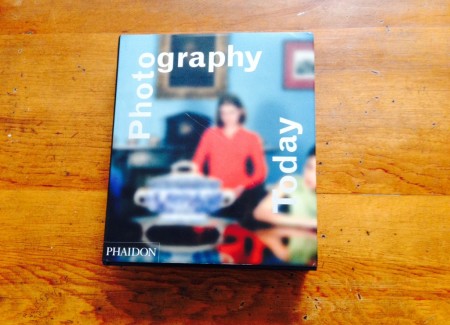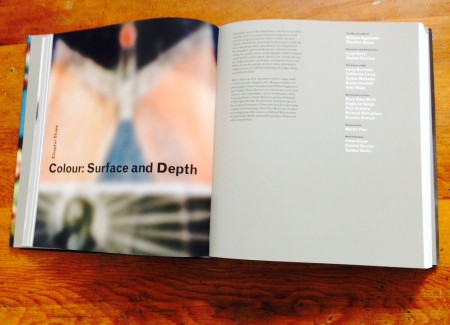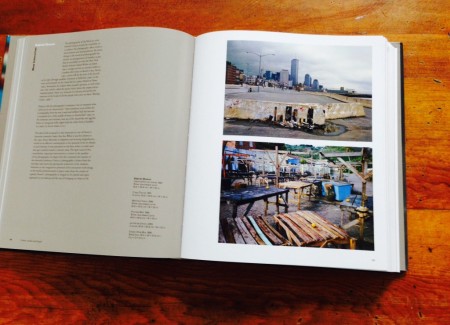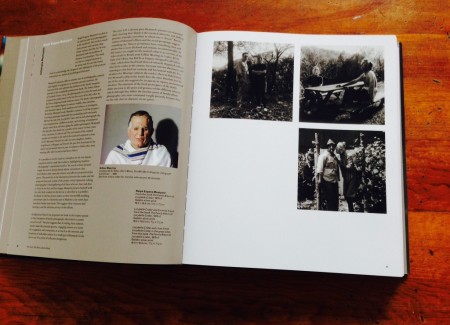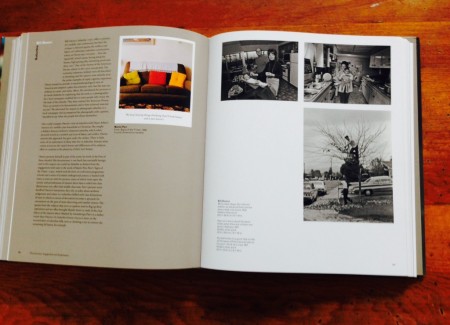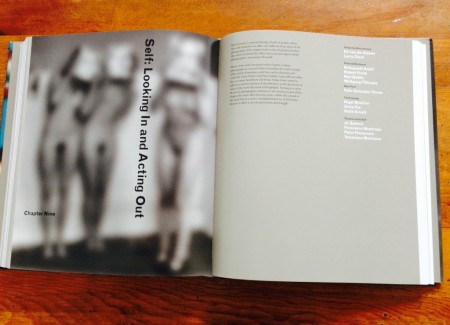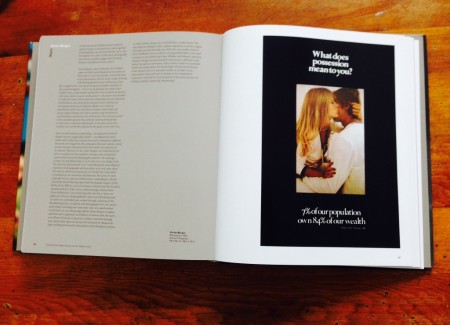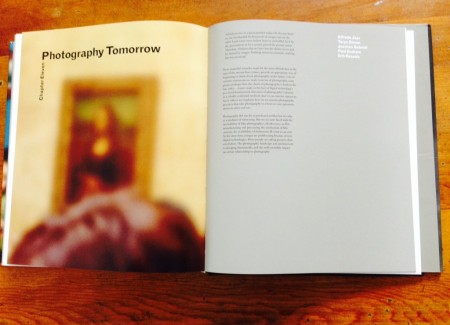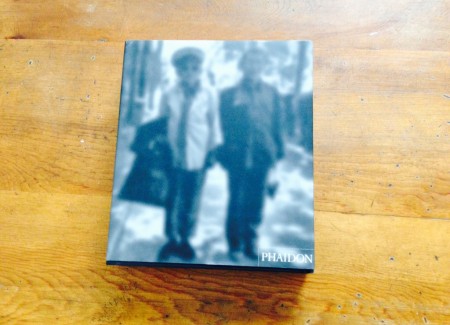JTF (just the facts): Published in 2014 by Phaidon Press (here). Hardcover (11 3/8 x 9 7/8 inches), 464 pages, with 500 black-and-white and color photographic reproductions. $75.
Comments/Context: Books proposing to comprehend the state of an art are usually out-of-date by the time they’re published. It can take years to choose pertinent images to support an argument, one that may have to be hastily recast after a failure to secure all of the reproduction rights. And that’s not counting months needed for editing, printing, binding, and distribution.
Surveys of contemporary photography have the added burden that its apparatus is updated annually or, in the age of apps, even sooner. This alarming fact can shape the concerns of an avant-garde as it responds to new—or foreclosed—possibilities for making or displaying images. As the rate of such changes varies country-to-country, with authors inevitably observing their local scene more closely than a foreign one, any attempt at a global perspective can’t help turning out to be slightly, or very, myopic.
For stepping over these demoralizing obstacles, Phaidon has our thanks. While its younger customers may prefer to inform themselves online, the publisher has invested considerable expense and thought into producing this thick paper brick of a book.
The artist and lecturer Mark Durden, currently a Professor of Photography at South Wales in the U.K., has been granted sole responsibility for mapping his field. To do so, he has chosen 163 living (and dead) photographers from more than 25 countries who are influencing practice around the world.
Each artist is given a write-up of about 500-1,000 words and between 1-9 illustrations (full-page images or spreads from books). Work is divided by subjects and styles and methods, as well as according to the problems (conceptual or societal) it raises, or the intentions of the artist. Each chapter discusses between 5-21 photographers in chronological order, from oldest to youngest.
The 11 chapters are: 1) “The Copy: Authorship and Reproduction”; 2) “The Face: The Pose and the Mask”; 3) “Color: Surface and Depth”; 4) “The Street: Discord and Harmony”; 5) “Landscapes: Nature, Culture and Power”; 6) “History: Witnessing Atrocity”; 7) “The Body: Ideal and Real”; 8) “Documentary: Engagement and Exploitation”; 9) “Self: Looking In and Acting Out”; 10) “Constructions: Signs, Fantasy, and the Tableau Form”; and 11) “Photography Tomorrow.”
Durden’s approach has its advantages. A thematic taxonomy allows more flexibility than a rigid chronological or a nationalistic one. Artists can be featured in two or more chapters instead of having their careers defined by a single idea or body of work. (Victor Burgin, Larry Burrows, Rineke Dijkstra, Paul Graham, Alfredo Jaar, Susan Meiselas, Daido Moriyama, Thomas Ruff, Sebastião Salgado, Joachim Schmid, Andres Serrano, Cindy Sherman, Thomas Struth, Joel Sternfeld, and Jeff Wall make multiple appearances.)
Living artists cohabiting on the page with dead ones is provocative but defensible, as media appropriators today continue to steal ideas from Robert Rauschenberg and Andy Warhol, and portraiture has not ceased looking back to Diane Arbus and Richard Avedon.The first four artists treated in the book are Rauschenberg, William Klein, Warhol, and Moriyama.
Many of the middle-aged art stars one would expect to find are here, such as Edward Burtynsky, Anne Collier, Paul Graham, Pieter Hugo, Erik Kessels, An-My Lê, Richard Learoyd, Shirin Neshat, Simon Norfolk, and Taryn Simon.
Durden also does a respectable job of identifying some of the less recognized international talent. He includes Idris Khan’s digital composites of photographs by the Bechers and Nicholas Nixon. Special attention is paid to Schmid and his colleagues at Useful Photography magazine, such as Ad Van Denderen, who like to recontextualize found vernacular photographs. Other interesting bodies of work glimpsed and concisely analyzed are Mintio’s multiple-exposures of obsessed teenage video gamers in Singapore; Philippe Chancel’s chilly color portraits from the utopia of North Korea; and Vandy Rattana’s bucolic Cambodian landscapes pockmarked by craters, a legacy of America’s air bombard-ment during the Vietnam War.
I was happy to learn more about British artists without much, or any, exhibition history in the U.S.: Anna Fox, whose diptychs join images of neat bland household items with texts of vicious remarks by her mother and father; Peter Finnemore, a whimsical Welsh mystical memoirist; Keith Arnatt, a photographer of funny trivia, such as the series of angry post-it notes left around the house by his wife after he has been out all night at the pub; and Nigel Shafran, who observes modern domesticity with the absurdist eye of Jacques Tati.
Less defensible are the American photographers missing from these pages. The established figures excluded would make a long list. To name only some who didn’t make the grade: Tina Barney, Uta Barth, John Divola, Mitch Epstein, John Gossage, Emmet Gowin, Katy Grannan, Barbara Kasten, Mark Klett, Ryan McGinley, Catherine Opie, John Pfahl, Alec Soth, and James Welling.
This is not to accuse him of British bias, as two other odd omissions are his countrymen Adam Fuss and Garry Fabian Miller. Rather, Durden’s outmoded framework is more likely at fault. Post-modern riddles about originality (Chapter 1) and elaborately staged tableaus (Chapter 10) seem, if not played out, then at least no longer “now.” Such emphases seem to have come at the expense of artists (Kelli Connell, Beate Gutschöw, Barry Frydlender) questioning optical veracity with digital manipulation. What’s more, the absence of who are re-exploring mergers of photography and sculpture (Yamini Nayar, Letha Wilson, Mariah Robertson) is disappointing. A lot of Photography Today reads like Photography Ten Years Ago.
Some thematic groupings provide jolts of insight. Sally Mann may not be happy being paired with Robert Mapplethorpe, but they’re related in their knowing manner and readiness to push our hot buttons. I had never connected Boris Mikhailov’s exploitive portraiture in the former Soviet Union with Hugo’s in Africa until Durden juxtaposed them in the “Documentary” chapter under the heading of “Excess.”
Other kinships make less sense. The chapter on “Color” begins with William Eggleston, Stephen Shore, and Luigi Ghirri, and then wants to mingle Andres Serrano, Larry Burrows, Susan Meiselas, Mary Ellen Mark, Daniela Rossell, Martin Parr, and Gabriel Orozco. Color is not an issue around which this disparate crowd should be asked to join hands. In the chapter on “The Body” under a subsection called “Performance,” Meiselas, because of her book Carnival Strippers (1976), is bookended by Ana Mendieta and Carolee Schneemann. It’s fine to try to dissolve borders between genres, but Meiselas’s Kurdistan: In the Shadow of History (1997), her masterly rethinking of what photojournalism should be, is nowhere cited in the book. (Then again, Durden deserves credit for avoiding the obvious, which would have been to have Carnival Strippers rub shoulders with Larry Sultan’s The Valley, his series on porn movie performers.)
Here’s a suggestion, though, for future surveys of similar ambition. Bringing photographers no longer alive closer to the forefront of contemporary practice is a sound idea. But instead of giving them full pages (or double pages), as Durden does here, why not put thumbnail images of them at the bottom of the page, as artists with similar artistic concerns or personal ties?
Readers wanting to pursue a set of influences to the main figure could then click (or flip). The large amounts of space given here to Bas Jan Ader, Arbus, Avedon, Guy Bourdin, Burrows, John Coplans, Roy DeCarava, Ed van der Elsken, Yves Klein, Ralph Eugene Meatyard, Helmut Newton, Rauschenberg, Allan Sekula, Ragubhir Singh, Sultan, Warhol, Garry Winogrand, and Francesa Woodman should be devoted to shining a brighter light on living talent.
If other choices made by the author are equally questionable—for a final chapter called “Photography Tomorrow” are Jaar, Simon, Schmid, Graham, and Kessels the ideal representatives?—the writing is mostly jargon-free and wide-ranging in its sympathies. (Durden’s impassioned advocacy of Robert Frank’s post-Americans pictures is especially acute.) Arbitrary and infuriating though the book may appear at first glance, its IQ goes up the longer you spend with it.
Collector’s POV: Given the nature of this broad survey, the usual discussion of individual galleries and secondary market histories has been omitted.
